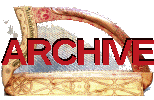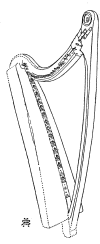

|

The Carolan harp in the NMI appears very plain. It has not been scientifically analysed, so we can’t be sure that it was never painted or coloured. It is possible that it was just finished with a shellac varnish.
The harp is however very nicely designed and proportioned. It is hard today, looking at the harp in its smashed and bandadged state, to appreciate its elegant lines and shape.
The most obvious decoration is the scroll carved at the head of the harp. This is a common feature of 18th century harps and other instruments, but this harp is unusual in that it is not actually a scroll; instead of a spiral, it is formed of concentric circles.
The forepillar of the harp is very elegantly shaped with a cut-away inner edge, giving the pillar a very subtle T-formation. The front of the pillar is not parallel-sided, but swells gently out to its widest point about three-quarters of the way up.
The lower edges of the soundbox are completely obscured by the bandage repairs. Now the harp looks like it has a plain straight edge, but you can see if you look carefully that the lower end of the soundbox is actually shaped into graceful curves, like the ‘lobes’ visible on the Downhill harp. Looking at the inside of the soundbox, two soundholes are visible down at the bottoms of the lobes.
The neck of the harp has a chamfered upper edge on each side.
The soundbox is quite plain, with no external string-rib, which adds to the clean lines of the harp. The string shoes, very unusually, alternate between two very different designs. One type is a flat triangular plate of metal, very similar to the shoes on the Downhill harp, with embossed ridges around the string hole and on the circular bulges that surround the nail-holes.. The other type is made from thick bent wire, the ends forged down into little flowers with punched petals. Both types are fixed on with two little nails. It is quite striking how they alternate, triangular and horseshoe-shaped, all the way down the front of the harp.
The tuning pins of the harp are good quality, made from brass in a lovely old-fashioned (“17th century”) style. They are of two types; the fat tapering drive ends have either crosses or diamonds incised on their square ends, which continue into engraved lines down the drive faces. Where the square drives blend into the cylindrical shafts are pairs of engraved bands. These pins look to me to be similar to the pins on the Downhill harp.
Simon Chadwick